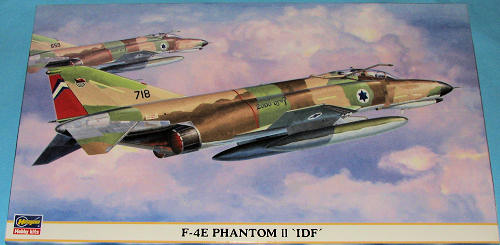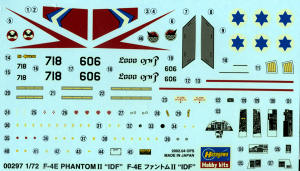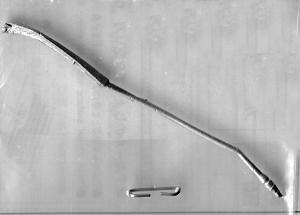
Hasegawa 1/72 F-4E "IDF"
| KIT #: | 00297 |
| PRICE: | $29.95 MSRP back in 2002 |
| DECALS: | Two options |
| REVIEWER: | Scott Van Aken |
| NOTES: | Includes cast metal refuelling probe |

| HISTORY |
To most knowledgeable and intelligent people, one of the finest jets of the Cold War is the F-4 Phantom II. Those lacking proper perception willundoubtedly differ in this matter, however, it isn't too late to come to yoursenses! :o)
Other than perhaps the Mig-17 or Mig-21, no other post-Koreanwar jet has been built in greater numbers. Certainly no other non-Sovietdesigned aircraft. There must have been a reason for it. It certainly isn'tsimplicity or ease of maintenance. The Phantom was one of the last Westernfighters where the airframe was designed first and then room was found for otherequipment. Nowadays, ease of maintenance is as important as any other factor. Itcertainly wasn't designed to be stealthy. Nothing like two smoke trailsfollowing several tons of hurtling metal to make yourself visible! It alsowasn't designed to be quiet. If you have ever been around the beast withoutproper hearing protection, your ears will definitely be ringing.
What made it such a success is that it was able to perform avariety of missions and perform them all well. Probably your first decentmulti-mission aircraft. It was an interceptor, a (unwilling) dogfighter, asuperb ground attack aircraft, a night fighter, a level bomber, a SAMsuppression aircraft, and a blast to fly. Before that, aircraft were generallyspecialized. After the Phantom, there were still purposefully built aircraft,but it lead the way to today's multi-mission aircraft.
Though mostly gone from the inventories of the world's air forces, The F-4 is still being flown by the Greeks, Turks and the Japanese amongst the few. The Greeks and Turks both had new build F-4Es and are recipients of low time ex-ANG planes; mostly from the Missouri and Indiana Guard units. The Japanese planes, aside from the first two EJs and the RF-4EJs, were all built under license by Mitsubishi. Though the numbers have dwindled down over the years, the F-4EJ kai is still being flown as are some that have been converted with recce pods.
Aside from the US, the most successful operators have been the Israelis with the IDFAF. Since their tankers use probe and drogue refueling, Israeli F-4Es were outfitted with an external fixed probe. These aircraft were later upgraded to "Kurnass 2000" standard and this kit's markings are for this upgrade.
| THE KIT |
The image of the sprues shows those areas of the F-4E kit that are different from the Navy F-4B/N/J/S kits. In fact, with this kit, you can build nearly any F-4E from the early Vietnam era gun Phantoms to the latest Japanese F-4EJkai. All of the different parts to do these versions are included in with the kit as there are multiple fin tip and gun nose variations as well as the different parabrake housings for each type. You have a choice of slatted or unslatted wings and two different centerline tanks are given; both early and the later F-15 type. However all these options comes with a price and that is that the kit is quite fiddly with many small parts. What it means to you as a builder is that you have to take your time and carefully fit all of these pieces in place. Just to give a brief rundown, you get finely engraved panel lines, a full cockpit though the instruments are decals (typical of many 1/72 kits and almost all of the Hasegawa ones), and no weapons. For weapons you'll need to spend the bucks on the required Hasegawa weapons set or scrounge them from your spares box.
 Instructions are the usual superb
Instructions are the usual superb Hasegawa ones giving Gunze paint references as well as FS numbers where they are required. All of the various bits needed to do a proper E variant are clearly shown. Since this is the Israeli Air Force version, you get a cast metal refueling probe. The kit has standard F-4E instructions with an addendum sheet to show installation of the probe and for the different decals. There are two options, One is for 201 Squadron, with the red rudder and the other with 119 Squadron with the red flash on the fin. While the Hasegawa markings are fine, you would be much better off to get those by Isradecal as the colors are more accurate and you will have a variety of markings options.
Hasegawa ones giving Gunze paint references as well as FS numbers where they are required. All of the various bits needed to do a proper E variant are clearly shown. Since this is the Israeli Air Force version, you get a cast metal refueling probe. The kit has standard F-4E instructions with an addendum sheet to show installation of the probe and for the different decals. There are two options, One is for 201 Squadron, with the red rudder and the other with 119 Squadron with the red flash on the fin. While the Hasegawa markings are fine, you would be much better off to get those by Isradecal as the colors are more accurate and you will have a variety of markings options.
| CONCLUSIONS |
While there are probably aftermarket bits to upgrade the kit to an IDF variant, it is nice to have everything in one box, especially as the casting is quite good. As mentioned there are better markings to be had, but these will do in a pinch. It is interesting to note that the 2012 price of a 1/72 Hasegawa Phantom is nearing $50, nearly double the price of ten years earlier.
| REFERENCES |
McDonnell F-4 Phantom: Spirit of the Skies, Aerospace Publishing.
Thanks to me for picking up this one.
If you would like your product reviewed fairly and fairly quickly, please contact the editor or see other details in the